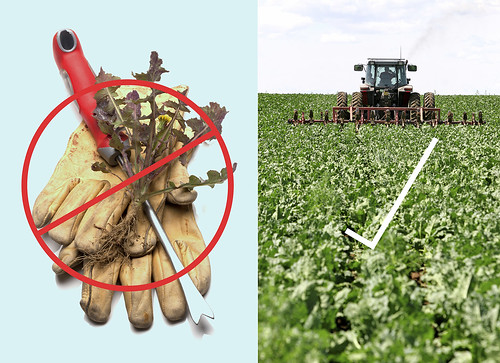
This is not your granddad’s weed whacker.
It is, in fact, a weed control system that farmers have only dreamed of – a high-speed machine that can not only distinguish weeds from the value crop, but can eliminate those weeds as carefully as a backyard gardener working by hand.
David Slaughter, of the University of California – Davis’ Department of Biological and Agricultural Engineering, and his team are developing new technologies that can accurately detect, locate, and kill weeds without damaging the cash crop. Their robotic cultivator is being developed as part of a $2.7 million Specialty Crop Research Initiative grant from the U.S. Department of Agriculture’s National Institute of Food and Agriculture (NIFA).
The secret is a sensor that gives the cultivator “eyesight” to tell friend from foe, and the key to that is coating the crop’s seeds with a special material prior to planting. As they sprout, the coating gives seedlings a faint fluorescent glow that the sensors detect. The coating is a short-lived inert material that wears off as the plant matures enough to out-compete weeds for light, water, and nutrients. The coating does not involve genetic modification or biotechnology; it is a safe, simple fluorescent material.
According to Slaughter, the “glow-in-the-dark” coating is a new application to an old agricultural concept. “Many people are familiar with how black light affects costumes and decorations at Halloween,” he said. Traditional uses for seed coating include fertilizers and pesticides.
Mounting the new NIFA-funded sensors on a tractor equipped with mini hoe-blades allows the Davis weeder to move much more rapidly than traditional cultivators. This higher speed means farmers can save up to 25 percent per acre off the cost of weeding by hand.
But there’s much more to the project than a “seeing-eye” cultivator; Slaughter’s team is also developing a high-speed, high-resolution, centimeter-scale sprayer that applies the herbicides with surgical precision. “The system pin-points the herbicides just to weeds and not the surrounding soil or crop,” Slaughter said. “We also have an organic version—developed and tested—that sprays hot canola oil on weeds to kill them without using conventional herbicides.”
The project began in September 2014 and will continue until August 2018. Field studies will be held in Arizona, California, and Washington to evaluate the technology under a wide range of growing conditions, including drip, furrow, and sprinkle irrigation systems and differences in weather.
While there is still much work to do, researchers believe that between the cultivator’s extreme precision and the dynamic micro-spray applicator, the project will not only save farmers money, but will prevent herbicide overload in the environment and cut down on farm workers’ exposure to chemicals.
Through federal funding and leadership for research, education, and extension programs, NIFA focuses on investing in science and solving critical issues impacting people's daily lives and the nation's future. For more information, visit www.nifa.usda.gov.



